Table of contents
- Which is the best sports tire of 2015? Hypersport tires and slicks in the test
- Not under 45 minutes and 70 to 80 degrees
- Tire air pressure and initial air pressure
- The fairy tale with the air pressure in cool weather
- Hypersport tires for the road
- Slicks up to 15 mm wider at the rear
- Mixtures for one to two day race training
- Bridgestone RS 10
- Metzeler Racetec RR (K3)
- Michelin Power Supersport Evo
- Pirelli Diablo Supercorsa SP
- Bridgestone V02
- Dunlop KR 106/108
- Metzeler Racetec Slick
- Michelin Power Slick Evo
- Pirelli Diablo Superbike
- This is how PS tests sports tires
- Explanation of tire approvals
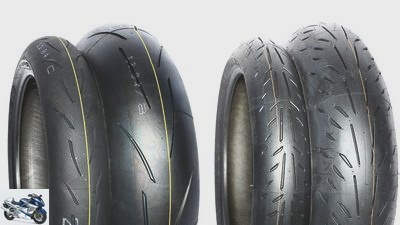
mps photo studio

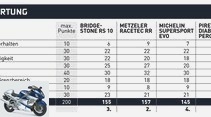

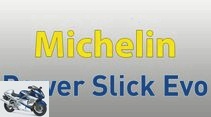
11 pictures
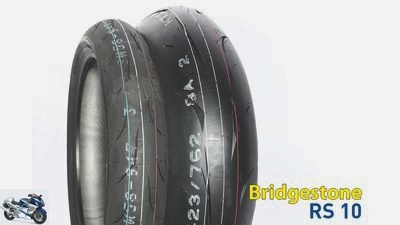
mps photo studio
1/11
The RS 10 is a very decent skin with many strengths and without significant weaknesses. Accordingly, it scores hard in every criterion, with one exception: cold running behavior. It is true that the rubber quickly builds up heat and thus grip. But the extremely slippery separating layer when new caused a real shock when it rolled up – be careful! The abrasion picture raises questions. After just two turns, the rear rubber showed the first signs of wear. The rear (cold) air pressure for the race is unusually low for a street sole: 1.5 bar.
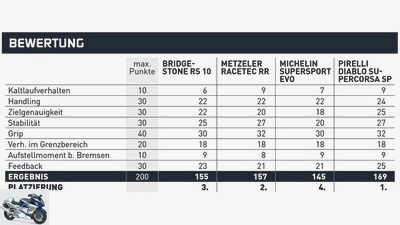
2/11
The overview tables (here part 1) show the performance of each individual candidate. This allows cross-comparisons between tread tires (here) and slicks (next picture).

3/11
One of the most prominent qualities of the Pirelli Diablo Superbike is well known: It shines with completely problem-free handling, regardless of the machine. This saves tedious adjustment work during the setup and scores plenty of points in terms of stability. In addition, it delivers fantastic grip. In terms of handling, accuracy and feedback, he only has to admit defeat to the bridge-stone, which is outstanding in this respect. Ultimately, he lands on the honorable second place.
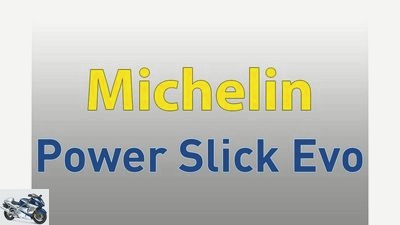
4/11
Except for the profile, the Power Slick Evo corresponds one to one to its patterned brother, the Power Cup Evo, a road-legal racing tire. This is probably the reason why the slick variant cannot quite catch up with the competition. As with the Supersport Evo (see page 53), there is always some restlessness in the framework. The Slick Evo isn’t the most red-hot iron in the Michelin fire. That means Power Slick Ultimate, it is a fine professional skin and unfortunately not available in Germany at the moment.

5/11
The Racetec Slick is an inconspicuous tire in a positive sense. He can do everything, does everything and shows no quirks. A good, absolutely problem-free all-rounder who, thanks to its elastic construction, can set itself apart from the competition in terms of stability thanks to its elastic structure. The grip is completely sufficient for hobby racers, but does not quite reach the level of the top rubbers. The price is interesting. Compared to the Pirelli, the Metzeler is around 17 percent cheaper.

6/11
As with the Bridgestone slicks, the Dunlops in Hatzenbach also get unrest in the chassis. The movements are even more pronounced. But the Dunlops are also leaving their mark on the rest of the slope. In the other criteria, the tire, which has been produced in France for some time, can fully convince. Especially when it comes to grip, he is one of the best. In terms of handling, accuracy, righting moment when braking in an inclined position and feedback, it fits well into the rest of the test field.

7/11
On the Bridgestones, the Suzuki can be driven phenomenally over the front wheel, even on the brakes. Thinking the dream line, bending it, fits to the millimeter. In addition, the V02 delivers first-class feedback both front and rear, and it is also one step ahead when it comes to handling. It also offers superb grip. The only question mark concerns the stability. In the fast Hatzenbachbogen, the hindquarters began to stir, which is why we had to take off the gas. On the rest of the route, however, the V02 ran absolutely without any problems, test victory.

mps photo studio
8/11
hat we didn’t expect: The longest-serving rubber wins the test – with a clear lead! With the Pirelli, the driver feels the proximity to a racing tire most clearly: laser-accurate and greedy turning, crisp handling, swift as an arrow in alternating curves, superb grip, the finest feedback, especially on the front wheel. In addition, the Diablo SP offers problem-free cold running behavior, at least when the outside temperature is around 15 degrees. The skin also provides the greatest fun factor, but of course this does not count towards the point evaluation. Clearly the first choice for sports drivers.
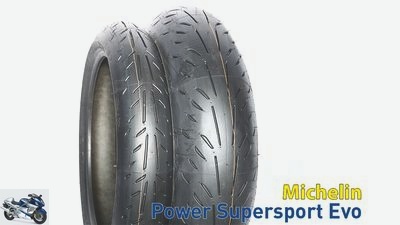
mps photo studio
9/11
The French convey a mixed picture. The excellent rear wheel grip, which the driver can feel very well, speaks for him. In terms of stability, however, the Evo weakens. Probably because of its rigid base
it absorbs bumps and impulses directed into the chassis only moderately, which creates noticeable restlessness in the Suzi. So fine tuning of the setup is necessary. Like the Bridgestone RS 10, it also shows clear signs of wear after two turns.
Great on the other hand: the Evo does not have the right to tilt when it is tilted.
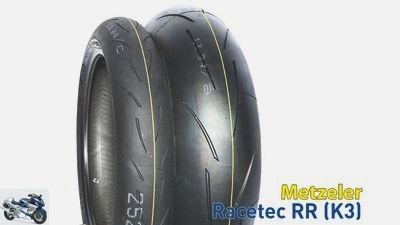
mps photo studio
10/11
The most outstanding characteristic of the Metzeler is its grip. Simply sensational, which adhesion the street skin builds up! In addition, the rubber offers first-class comfort, which means that the test Suzuki GSX-R 1000 burns wonderfully quiet and stable over the slopes. However, the successor to the legendary Racetec Interact leaves minimal feathers in terms of accuracy and feedback. In addition, it stands up easily when braking in an inclined position. The bottom line is that the RR is a good-natured and reliable partner with whom sports pilots can’t go wrong.
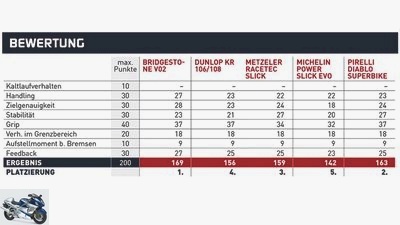
11/11
But be careful: Since we logically did not test the cold running properties of the slicks, they lack these counters in the end result. A direct comparison of the placements is therefore not possible. But in the individual criteria.
accesories
tire
What is the best motorcycle sport tire of 2015?
Which is the best sports tire of 2015?
Hypersport tires and slicks in the test
Content of
The track leads to the GP circuit of the Nurburgring. There we are looking for the best sports tires of 2015. Nine sports tires are competing in the comparison test: four hypersport tires for the road and five slicks for the racetrack.
Volkmar Jacob
06/16/2015
The investigators have no mercy. They persistently squeeze the nine delinquents until they reveal each of their secrets. Perpetrator profile: motorcycle sport tires. Verdict: guilty! Every suspect is convicted of street robbery on a large scale, no error can be made. All that remains is the question of the leader: which of these dark figures is the rubber king, uh, the best sports tire of 2015?
Buy complete article
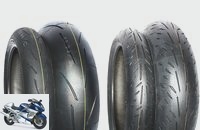
Which is the best sports tire of 2015?
Hypersport tires and slicks in the test
8 pages) as PDF
€ 2.00
Buy now
In our annual tire test, this time we focus on two types: sport skins and slicks. The former often have the suffix “Hypersport” and should be suitable for both country roads and hot laps on the racetrack without any restrictions. We’ll get to them in a moment.

tire
6 pairs of touring tires in the test
Touring tires on Suzuki GSX-S 750
read more
Not under 45 minutes and 70 to 80 degrees
The profile-less variant, on the other hand, is only allowed to play on the slopes. The reason is simple: slicks need higher temperatures to work properly. But even with a bold driving style in public areas, this cannot be achieved, at least not in the long term. In addition, the racing rubbers are logically not approved for the road due to their lack of profile. And they need to be preheated. The manufacturers agree on this: Nothing works for less than 45 minutes – better: 60 minutes – and a heating ceiling temperature of 70 to 80 degrees.
Tire air pressure and initial air pressure
If you drive too cautiously, slicks cool down, which can have negative consequences for grip. But how does a pilot know whether he has the necessary speed for slicks? To do this, you check the air pressure just before you set off and immediately after the end of the turn. If the manometer shows less afterwards than before, the soles are not being stressed enough. Normally, the air pressure increases by a few tenths, depending on the tire, with appropriate exercise.
A science in itself is the ideal starting air pressure. The values can fluctuate depending on the track temperature, the rubber compound and the nature of the asphalt (rough or fine structure). There are also big differences between the tire brands. Pirelli recommends, for example, an air pressure of 1.6 to 1.8 bar for his rear slick, while Dunlop only requires 1.2 bar (both preheated). This mainly has to do with the tire structure (hardness of the carcass). Very stiff skins require less air pressure than elastic ones. A good racing service knows the ideal value under the respective conditions. Or you can contact the tire company. Occasionally, these already provide very meaningful information on the Internet. For this test, we followed the manufacturer’s recommendations that are in the respective tire boxes. Usually only one value is listed there (cold or preheated). Please do not confuse them!
The fairy tale with the air pressure in cool weather
At this point we would like to dispel a widespread misconception. Would-be professionals sometimes recommend reduced air pressures at low temperatures. But that’s wrong! Because this causes the tire to flex more, which, in combination with the high temperature differences within the rubber layers, leads to cracks. A higher air pressure is better because the rubber heats up more at certain points due to the smaller contact area.
One last, important point on this subject. In the case of road-legal tires, the recommendations for the slopes differ greatly from those for public areas. Cold air pressures of 2.5 bar (front) and 2.9 bar (rear) usually apply there. The higher values compared to the racetrack offer more reserves, for example with a fully packed bike or continuous high-speed on the motorway. So never bolt here with air pressure that is too low.
Hypersport tires for the road
Let’s stay with the sporty grooved tires. A lot has happened in this category this year. Bridgestone, Metzeler and Michelin unleash new or heavily revised rubbers on the sport-hungry pack. The three soles compete against the winner of the last hypersport tire test, the Pirelli Diablo Supercorsa SP. Unfortunately, Dunlop has no new iron in the fire with the GP Racer D 211, and Continental did not want a preliminary test of its brand new product. It is a matter of honor that we provide a comparison with this sports tire. Originally, Conti also wanted to present a new slick. But for “technical production reasons”, according to the manufacturer, the date has been postponed to 2016. We will also be introducing this sports tire in due course.
But today we will first take care of the candidates who are present. We feel the street pelts in the dimensions 120/70-ZR 17 and 190/55-ZR 17 on the flanks. There are already some 200 mm tires on the market, but the majority of sports drivers still shoot around with the slightly narrower version. In addition, “the difference in handling and the tire contact area is negligible,” as a Pirelli spokesman assures.
Slicks up to 15 mm wider at the rear
We also ordered the five slick pairs in the sizes mentioned, but at least with the rear wheel, each manufacturer does its own thing. The designations range from 190/60 (Metzeler) to 195/65 (Dunlop) and 200/55 (Michelin) to 200/60 (Pirelli) and 200/655 (Bridgestone). As a result, the tire widths and the rolling circumferences sometimes differ significantly. Basically, the rear slicks are wider and higher than their street-legal counterparts. The difference is up to 15 millimeters (width) and 4.5 millimeters (rolling circumference).
The rolling circumferences differ even more than the series tires of the test GSX-R 1000. Because of its no longer contemporary 50 mm cross-section (190/50), it measures a whopping 114 millimeters less than the largest circumference (Michelin Power Slick Evo, Pirelli Diablo Superbike). As a result, the rear of all test candidates protrudes a little higher and the gear ratio is also longer. Why? Because the rear wheel turns more slowly at the same vehicle speed. Therefore the speedometer shows lower values. Of course, that doesn’t matter on the race. But if you want to hunt in the wild with a dimension other than the prescribed one, you need a clearance certificate from the manufacturer.
Mixtures for one to two day race training
Finally, a few words about the test features. For the slicks, we ordered compounds that can withstand one to two-day racing training from amateur racers. Since we completed the test as part of a highly frequented training session, we did not determine any lap times. Only the popometer counted. As the two of them feel more than one, Michael “Gotzi” Gotz supported us with the happy tire burning on the ring. Gotzi is a veteran of the fast guys from the Yamaha Cup.
The subject of wear and tear: Spin all the sports tires until they wave the white flag at the Nurburgring, nothing better than that! But with nine pairings that is beyond our time frame. This criterion must therefore be disregarded. All candidates are listed next to each other in the overview table. This simplifies cross-comparisons, also between tread tires and slicks. But be careful: only road tires have the “cold running behavior” criterion. Since this affects the total number of points, a direct comparison of the end result between hypersport tires and slicks is not possible. This is another reason why there are two rubber kings. Which? You can see this on the following pages and in the picture gallery.
Bridgestone RS 10
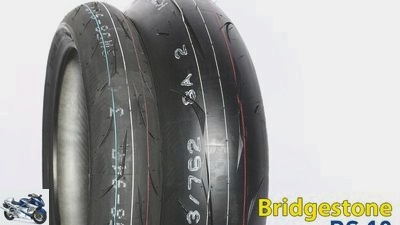
mps photo studio
Bridgestone RS 10
The RS 10 is a very decent sports tire with many strengths and without significant weaknesses. Accordingly, it scores hard in every criterion, with one exception: cold running behavior. It is true that the rubber quickly builds up heat and thus grip. But the extremely slippery separating layer when new caused a real shock when it rolled up – watch out! The abrasion picture raises questions. After just two turns, the rear rubber showed the first signs of wear. The rear (cold) air pressure for the race is unusually low for a street sole: 1.5 bar.
Metzeler Racetec RR (K3)
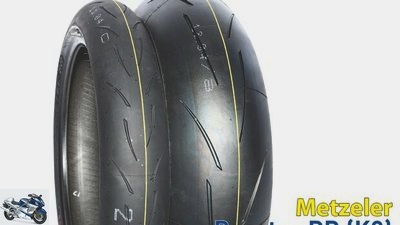
mps photo studio
Metzeler Racetec RR (K3)
The most outstanding characteristic of the Metzeler is its grip. Simply sensational, which adhesion the street skin builds up! In addition, the rubber offers first-class comfort, which means that the test Suzuki GSX-R 1000 burns wonderfully quiet and stable over the slopes. However, the successor to the legendary Racetec Interact leaves minimal feathers in terms of accuracy and feedback. In addition, it stands up easily when braking in an inclined position. The bottom line is that the RR is a good-natured and reliable partner with whom sports pilots can’t go wrong.
Michelin Power Supersport Evo
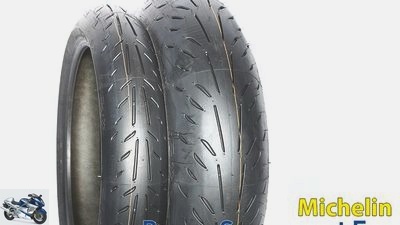
mps photo studio
Michelin Power Supersport Evo
The Michelin Power Supersport Evo gives a mixed picture. The excellent rear wheel grip, which the driver can feel very well, speaks for him. In terms of stability, however, the Evo weakens. Presumably because of its rigid substructure, it absorbs bumps and impulses directed into the chassis only moderately, which creates noticeable unrest in the Suzuki. So fine tuning of the setup is necessary. To this end, he too points out Bridgestone RS 10 shows clear signs of wear after just two turns.
Great on the other hand: the Evo does not have the right to tilt when it is tilted.
Pirelli Diablo Supercorsa SP
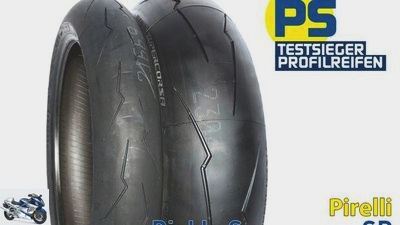
mps photo studio
Pirelli Diablo Supercorsa SP
We didn’t expect that: The longest-serving rubber wins the test – with a clear lead! With the Pirelli, the driver feels the proximity to a racing tire most clearly: laser-accurate and greedy turning, crisp handling, swift as an arrow in alternating curves, superb grip, the finest feedback, especially on the front wheel. In addition, the Diablo SP offers problem-free cold running behavior, at least when the outside temperature is around 15 degrees. This sports tire also provides the highest fun factor, which of course does not count towards the points. Clearly the first choice for sports drivers.
Bridgestone V02
On the Bridgestones, the Suzuki can be driven phenomenally over the front wheel, even on the brakes. Thinking the dream line, bending it, fits to the millimeter. In addition, the V02 delivers first-class feedback both front and rear, and it is also one step ahead when it comes to handling. It also offers superb grip. The only question mark concerns the stability. In the fast Hatzenbachbogen, the hindquarters began to stir, which is why we had to take off the gas. On the rest of the route, however, the V02 ran absolutely without any problems, test victory.
Dunlop KR 106/108
As with the Bridgestone slicks, the Dunlops in Hatzenbach also get unrest in the chassis. The movements are even more pronounced. But the Dunlops are also leaving their mark on the rest of the slope. In the other criteria, the tire, which has been produced in France for some time, can fully convince. Especially when it comes to grip, he is one of the best. In terms of handling, accuracy, righting moment when braking in an inclined position and feedback, it fits well into the rest of the test field.
Metzeler Racetec Slick
The Racetec Slick is an inconspicuous tire in a positive sense. He can do everything, does everything and shows no quirks. A good, absolutely problem-free all-rounder who, thanks to its elastic construction, can set itself apart from the competition in terms of stability thanks to its elastic structure. The grip is completely sufficient for hobby racers, but does not quite reach the level of the top rubbers. The price is interesting. Compared to the Pirelli, the Metzeler is around 17 percent cheaper.
Michelin Power Slick Evo
Except for the profile, the Power Slick Evo corresponds one to one to its patterned brother, the Power Cup Evo, a road-legal racing tire. This is probably the reason why the slick variant cannot quite catch up with the competition. As with the Supersport Evo, there is always some restlessness in the framework. The Slick Evo isn’t the most red-hot iron in the Michelin fire. That means Power Slick Ultimate, it is a fine professional skin and unfortunately not available in Germany at the moment.
Pirelli Diablo Superbike
One of the most prominent qualities of the Pirelli Diablo Superbike is well known: It shines with completely problem-free handling, regardless of the machine. This saves tedious adjustment work during the setup and scores plenty of points in terms of stability. In addition, it delivers fantastic grip. In terms of handling, accuracy and feedback, he only has to admit defeat to Bridgestone, which is outstanding in this respect. Ultimately, he lands on the honorable second place.
This is how PS tests sports tires
We did the tire test on a Suzuki GSX-R 1000. A puristic bike that, apart from various motor mappings and ABS, does not require any other electronic driving aids. We disconnected the ABS for better comparability of the tires.
We assessed the following criteria:
Cold running behavior (only tread tires)
How long does a tire take to reach operating temperature, how does it feel when it warms up??
Handling
What steering force is required to tilt the bike or to keep it in line in slow / fast alternating curves?
Accuracy *
It is determined in passages at different speeds with different curve radii and provides information on how the motorcycle is following the desired course, which is specified by the steering forces, or whether significant line corrections are required.
stability
How stable is the motorcycle? Does the tire lead to unrest in the chassis? The stability is also tested in different speed ranges in large lean angles when accelerating, where tires can rock up.
Grip *
Is the sum of the total liability of a tire. It includes the lateral grip, i.e. the lateral guidance in maximum inclination on dry asphalt and the grip when accelerating on the straight. A tightrope walk that is only possible on a closed route.
Behavior in the border area *
Controllability of the tire at the limit of grip.
Erection moment
When braking in an inclined position, the motorcycle straightens up to different degrees depending on the deceleration and tire contour. The driver has to compensate for this reaction with a counterforce (push) on the inside of the handlebar.
Feedback
What feedback does a tire provide to the pilot? The clearer the feedback, the easier it is to drive in the limit area.
* The chapters marked with an asterisk can be transferred to motorcycles with a geometry similar to that of the Suzuki GSX-R 1000.
Explanation of tire approvals
If there is no entry in the registration certificate (vehicle registration document) under number 22, there is no tire binding and you can put on your favorite sole without hesitation. However, this must correspond to the entries in fields 15.1 and 15.2, which, among other things, specify the dimensions. If there is an entry at number 22, this can be avoided by means of so-called clearance certificates (“releases”). You can get them directly from the tire manufacturers, for example. When it comes to the question of whether manufacturers are also allowed to release dimensions other than those prescribed, opinions differ. The tire industry and the Federal Ministry of Transport say “yes”.
TuV Nord sees it differently. A constant controversy also in the biennial investigation. So it remains exciting.
Related articles
-
Jahn accesories tire The 2013 PS sports tire test The 2013 PS sports tire test 6 sports tires in the horsepower test Content of Sports tires are our…
-
Sports tires in the 2013 tire test
Jahn 23 pictures Jahn 1/23 The 2013 MOTORRAD sports tire test. Jahn 2/23 The sports tires on the country road and motorway. Jahn 3/23 Where did the…
-
www.jkuenstle.de 20th pictures www.jkuenstle.de 1/20 Under adverse conditions, i.e. wet, cold or the nasty combination of these two weather situations,…
-
Sports tire 2021 on the Yamaha R1 in the test
Markus Jahn, mps photo studio, Yamaha 17th pictures Markus Jahn, mps photo studio, Yamaha 1/17 Six cutting-edge sports rubbers have to prove their…
-
Best purchase for sports tires (MOTORRAD 13-2013)
Jahn 23 pictures Jahn 1/23 The 2013 MOTORRAD sports tire test. Jahn 2/23 The sports tires on the country road and motorway. Jahn 3/23 Where did the…
-
Best purchase for sports tires (MOTORRAD 10-2014)
mps studio accesories tire Buying tip for sports tires (MOTORRAD 10/2014) Best purchase for sports tires 120/70 ZR 17 and 190/55 ZR 17 (MOTORRAD 10/2014)…
-
Endurance test of Dunlop sports tires
Bilski 29 pictures Bilski 1/29 PS brought in IDM superbike ace Gareth Jones as a co-tester. Bilski 2/29 Dunlop Sportsmart: mileage 6,500 km; Costs per km…
-
The right tire choice for a motorcycle
Markus Jahn 26th pictures MOTORCYCLE 1/26 On the way on alpine passes? That’s how it works! MOTORCYCLE 2/26 Seductive winding curves with risk. The…
-
Sports tires in a comparison test
fact / Joachim Schahl 17th pictures fact 1/17 The different criteria of four different rubbers need to be neatly noted. Later confusion excluded. fact…
-
PS reader question on motorcycle technology – tire wear on the racetrack
jkuenstle.de 5 pictures markus-jahn.com 1/5 “What is the reason for the flaky, frayed way in which racing tires are destroyed??”, asks us reader Holger…